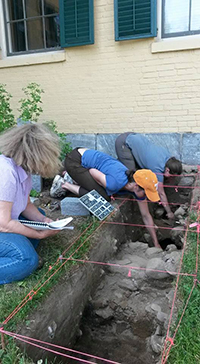The Dickinson Homestead
By Linda Santoro
 Archaeology is one way for us to learn more about people in the past, and perhaps few people could use illuminating as Emily Dickinson. Often referred to as a natural recluse, Emily Dickinson staunchly refused to show her poems to those outside her closest circle at home, and it was only after her death that she won fame for her poetry. We have her writings and her poems that allow us a glimpse into how she thought, but we also have the place she spent the majority of her life, the Dickinson Homestead in Amherst, Massachusetts.
Archaeology is one way for us to learn more about people in the past, and perhaps few people could use illuminating as Emily Dickinson. Often referred to as a natural recluse, Emily Dickinson staunchly refused to show her poems to those outside her closest circle at home, and it was only after her death that she won fame for her poetry. We have her writings and her poems that allow us a glimpse into how she thought, but we also have the place she spent the majority of her life, the Dickinson Homestead in Amherst, Massachusetts.
In 2003, Amherst College started the Emily Dickinson Museum, combining the Dickinson Homestead property and the Evergreens property, where Emily's brother and sister in law lived. The Dickinson Homestead was built in 1813 by Emily's grandfather, Samuel Fowler Dickinson. His son Edward, Emily's father, lived there for a short time, but moved after the birth of his two daughters, Emily and Lavinia. The family returned to the Homestead in 1855 and made many changes to the buildings and landscape, including the construction of the Evergreens. The landscape was designed as a 18th century gentleman's farm, complete with livestock, fruit orchard, and vegetable garden. As stewards of all things Dickinson, the Museum has undertaken preservation and restoration of both the properties and the associated landscape, including supporting archaeological investigations.
The image featured on this year's Archaeology Month poster is of the archaeological field school conducted by the University of Massachusetts at Amherst in 2015. One of the goals of the field school was to better understand the construction methods of the former Conservatory, pictured in the photo above, which had been demolished in 1915. Edward Dickinson had the conservatory constructed in 1855 for use by his daughters. Caring for the various exotic and local plants was very influential on Emily and her relationship with nature, a topic that would come up frequently in her most famous poems. In fact, it is documented that Emily frequently worked at a writing desk in the dining room that faced the conservatory.

The field school placed a large trench along the historic conservatory walls, its location having been determined from historic photographs and maps. There they uncovered more of the historic conservatory's stone foundation, a potential builder's trench related to the construction of the conservatory, and artifacts such as ceramics, pipe stems and bowls, and architectural debris.
The Emily Dickinson Museum is using the information uncovered during the archaeological field school to inform the future construction of a new conservatory, including the use of historic materials. The archaeologists will return to the Dickinson Homestead to search out the location of past gardens, hopefully locating planting beds and potentially even seeds, in order to further document what was grown at the Dickinson Homestead. All of this information will be used by the Museum to help recreate the conservatory and gardens that so inspired Emily Dickinson.